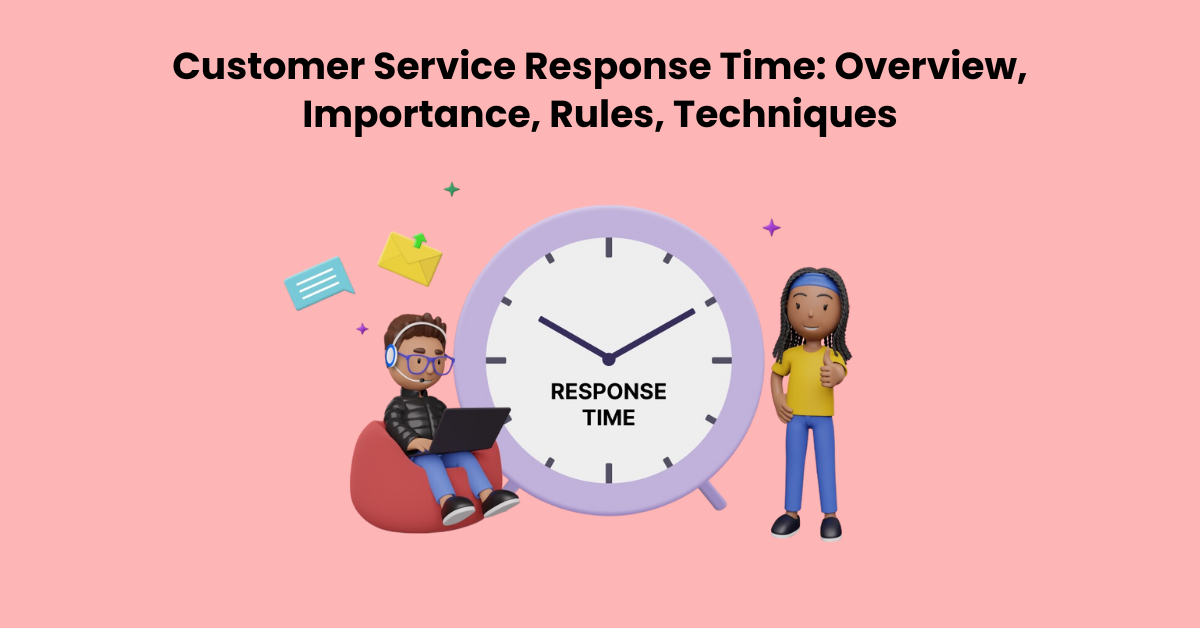Customer Service Response Time: Overview, Importance, Rules, Techniques

When it comes to providing customer service, promptness of reaction is crucial. We'll explore the essential elements of customer service reaction time in this blog article, including what it comprises, why it matters, and practical management strategies. Businesses can improve customer satisfaction and build deeper customer connections by realizing the value of prompt responses and putting them into practice. We'll go over key guidelines and methods to assist you expedite the response process and guarantee that your clients are made to feel important and heard. Come along as we explore the subtleties of response times for customer service and learn how to attain greatness in this important area of customer care.
Customer Service Response Time: Overview

Customer Service Response Time refers to the duration it takes for a business or organization to respond to a customer's inquiry, request, or concern. It encompasses the time from when a customer reaches out for assistance to when they receive a satisfactory response. customer service response time statistics can include various communication channels such as phone calls, emails, live chats, social media messages, and support tickets. Effective management of response time is essential for ensuring customer satisfaction, as prompt and efficient responses demonstrate attentiveness, reliability, and a commitment to addressing customer needs on time.
Importance of Response Time In Customer Service

Here are 5 reasons why response time is important in customer service:
Increased Customer Satisfaction: Customers who experience fast response times tend to be happier with the overall service experience. A prompt response shows customers you value their time and their business.
Builds Trust and Loyalty: When customers feel their concerns are addressed quickly, it builds trust and fosters loyalty. They're more likely to return for future purchases and recommend your brand to others.
Reduces Frustration and Churn: Slow response times can lead to frustration and a feeling of being ignored. This can cause customers to abandon their inquiries or take their business elsewhere.
Improves Sales and Revenue: Studies show customers are willing to spend more with businesses that prioritize fast and efficient customer service.
Boosts Brand Image: A reputation for quick and helpful customer service can significantly improve your brand image. It shows you care about your customers and are committed to their satisfaction.
Customer Service Response Time Rules
Effective management of customer response time relies on several key rules:
Prioritize Urgency: Assess the urgency of each customer inquiry and respond accordingly. Address high-priority issues promptly to prevent escalations and mitigate dissatisfaction.
Set Clear Expectations: Communicate realistic response times to customers upfront, managing their expectations from the outset. Transparency builds trust and reduces frustration.
Define Service Level Agreements (SLAs): Establish SLAs that outline specific response time goals for different channels and types of inquiries. Consistently meet or exceed these commitments to uphold customer satisfaction.
Implement Automation Wisely: Utilize automation tools to streamline routine tasks and facilitate faster response times. However, balance automation with human interaction to maintain a personalized customer experience.
Monitor Performance Metrics: Regularly track response time metrics to identify areas for improvement and ensure compliance with SLAs. Analyze trends and customer feedback to refine your approach continually.
Empower Frontline Staff: Equip frontline staff with the resources, training, and authority needed to resolve issues promptly. Encourage a customer-centric mindset to prioritize responsiveness in all interactions.
Foster Collaboration: Foster collaboration among customer service teams, departments, and stakeholders to streamline communication and problem-solving processes. Break down silos to facilitate swift resolution of customer issues.
How To Improve Response Time To Customer?
Improving response time to customers involves several key strategies:
Utilize Automation: Implement automation tools such as chatbots and email autoresponders to acknowledge customer inquiries instantly. These tools can handle routine queries and provide immediate assistance, freeing up human agents to focus on more complex issues.
Adding an AI Shopping Assistant: It can significantly reduce response times by providing instant answers to common customer queries. This ensures customers receive timely support, enhancing their overall experience. Additionally, it allows human agents to focus on more complex issues, improving efficiency and satisfaction
Optimize Workflows: Streamline internal processes to minimize response time. Review and refine the customer service workflow to eliminate bottlenecks and unnecessary steps that delay responses.
Prioritize Channels: Identify the most frequently used communication channels by your customers and allocate resources accordingly. Focus on channels where customers expect quick responses, such as live chat or social media platforms.
Implement Service Level Agreements (SLAs): Define clear SLAs that outline response time expectations for different types of inquiries. Monitor performance against these SLAs and adjust workflows or staffing levels as needed to meet targets.
Train and Empower Staff: Provide comprehensive training to customer service representatives to equip them with the skills and knowledge needed to handle inquiries efficiently. Empower frontline staff to make decisions and resolve issues independently, reducing the need for escalation.
Invest in Technology: Invest in technology and tools that facilitate faster response times, such as customer relationship management (CRM) systems, helpdesk software, and communication platforms. These tools can centralize customer information, automate tasks, and streamline communication.
Monitor and Analyze Metrics: Regularly monitor response time metrics and analyze trends to identify areas for improvement. Use customer feedback and satisfaction surveys to gain insights into the effectiveness of your response efforts and make data-driven decisions.
Provide Self-Service Options: Offer self-service options such as knowledge bases, FAQs, and online forums where customers can find answers to common questions without having to contact support. This reduces the volume of inquiries and speeds up response times for more complex issues.
Conclusion
Prioritizing response time and putting this blog's suggested tactics into practice will greatly improve your customer support experience. Recall that prompt service shows that you respect your clients' demands. This leads to more sales and a better reputation for the brand in addition to fostering loyalty and trust. Thus, if you base your customer service approach on effective communication, you'll see a sharp increase in client satisfaction.

.png)
